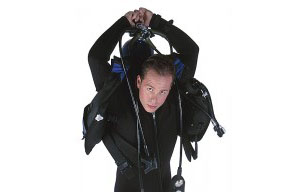Part 2 of 3
The Shape-up for diving guidelines
 One more thing. All the skills are tested usually in one day, which could extend to up to two hours of continuous activity. Also, the diving gear is heavy. It is designed to be neutrally buoyant under water, but to get there, you have to haul it on the surface first. Have you ever tried swimming against a current? Sooner or later you will have to, especially since you do not get a diver certification until you complete a minimum of 4 or 5 dives IN OPEN WATER.
One more thing. All the skills are tested usually in one day, which could extend to up to two hours of continuous activity. Also, the diving gear is heavy. It is designed to be neutrally buoyant under water, but to get there, you have to haul it on the surface first. Have you ever tried swimming against a current? Sooner or later you will have to, especially since you do not get a diver certification until you complete a minimum of 4 or 5 dives IN OPEN WATER.
Being fit is a priority for all divers and diver candidates. By being in shape, you can be sure that the demands imposed will not hinder your enjoyment of the activity. You will also be more likely to use less air, which in turn results in longer bottom times, and that is what diving is all about. If you take the time to analyze the diving accident reports, you will find out that poor physical fitness is a major factor in a significant number of them.
The shape-up guidelines will provide you with information on how to focus your routines so that you can derive the most enjoyment out of your instruction and diving times. It is important that you have access to a swimming pool and practice your swimming. None of the exercises below will replace the skills and specific endurance developed by the constant practice of swimming.
Back and Trunk Strength
In general, human beings are buoyant. More so in salt water than in fresh water. That means that we need weights to help us descend. The most popular form of weights comes in a belt to which you attach lead squares until you find a weight that suits you the best. This takes experimentation and is different from person to person so be patient.
The weight of the lead and the weight of the tank can put considerable demands on your back. Several back stabilizing muscles work hard during swimming to keep your hips stable, so having a strong back is essential. A lot of the more modern Buoyancy Compensators include padded and/or ergonomic back support along with integrated weight systems that alleviate some of the stress, but nothing beats having a strong back.
The other side of the trunk is composed of the abdominal muscles and obliques. While they do require training, they do not need the overrated attention that most people put on them. Most people have a pretty good idea of what to do. One thing that needs to be addressed though is that to strengthen the abdominals, hundreds of reps are not the way to go. That goes well for endurance, but NOT strength. If you can do an abdominal exercise for more than 15 reps, then switch to a more challenging routine. The back muscles on the other hand receive very little attention since most people have the erroneous tendency to believe that working their abdominals will do a lot more for their backs than working the back muscles themselves. That unfortunately is not the case. Here are a few back exercises:
Deadlifts
 Performed correctly, they are one of the best overall conditioning exercises. Granted that diving requires more endurance than strength, but remember that you still need the strength to haul the equipment, climb back to the boat, or the beach if you do a shore entry. I prefer the Olympic Lifter style of dead-lifting since it puts a lots more emphasis on the posterior leg and hip muscles not to mention the back. You will not be able to lift as much weight as sumo-style dead-lifting of powerlifters, but that is not important since it is not max strength what we are trying to accomplish.
Performed correctly, they are one of the best overall conditioning exercises. Granted that diving requires more endurance than strength, but remember that you still need the strength to haul the equipment, climb back to the boat, or the beach if you do a shore entry. I prefer the Olympic Lifter style of dead-lifting since it puts a lots more emphasis on the posterior leg and hip muscles not to mention the back. You will not be able to lift as much weight as sumo-style dead-lifting of powerlifters, but that is not important since it is not max strength what we are trying to accomplish.
Good Mornings
Good endurance builder, will make for a good change of pace when not dead-lifting. Make sure to keep your back neutral when performing this exercise.
Hypers/Reverse Hypers
Hyperextensions, back extensions, and reverse hypers can be performed at their respective stations, the floor, or a physioball depending on your level of fitness. They can also be combined with reverse dumbbell flies for a more advanced exercise. Alternate both forms for more thorough training.
